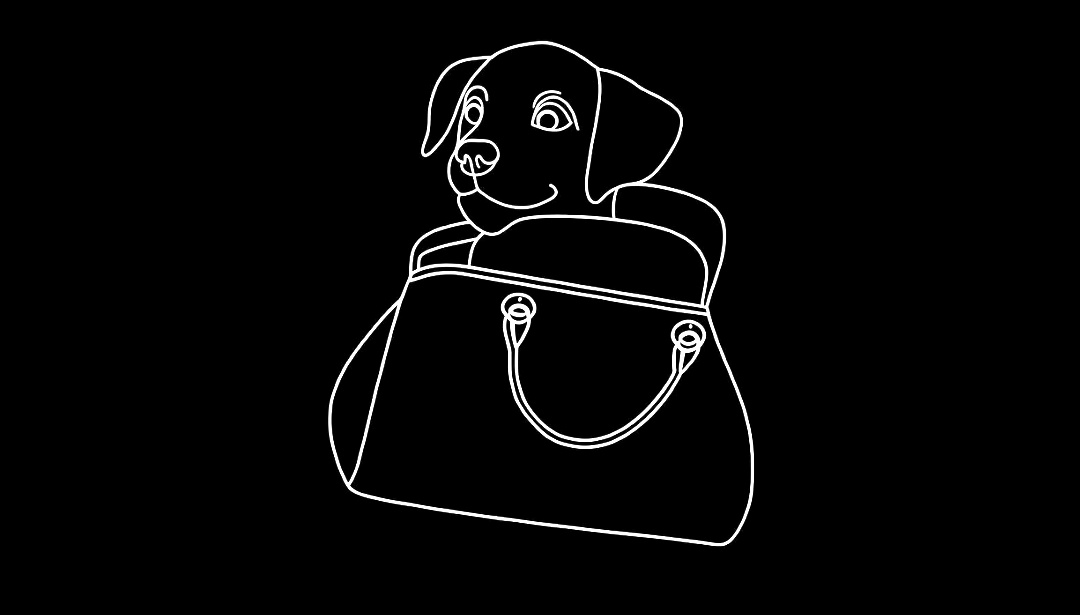Abstract
Autistic individuals often exhibit reduced attention to faces and eyes, which may underlie their social difficulty. This study used eye-tracking techniques to explore visual attention towards faces in Shank3 mutant laboratory beagle dogs, a model for autism, to identify parallels with human autism. We first assessed visual attention differences towards the eyes between Shank3 mutant and wild-type (WT) laboratory beagles by presenting them with human and dog face images. Then, using the gaze cueing paradigm, we directed the dogs’ gaze towards the eyes and mouth and quantified their gaze shifts. Finally, we investigated the impact of oxytocin on eye-gaze behavior by comparing gaze patterns under pre-administration, vehicle, and oxytocin conditions while viewing human faces. We found that mutant dogs showed a reduced proportional viewing time of human eyes than WT dogs (p = 0.032), but no difference in proportional eye viewing time when viewing dog faces (p = 0.691). Mutant dogs shifted their gazes away from the human eyes more quickly than the mouth (p = 0.043), unlike WT dogs (p = 0.345), suggesting an active eye avoidance. Furthermore, exogenous oxytocin increased proportional viewing time on human eyes in mutant dogs than pre-administration and vehicle conditions (p = 0.022), suggesting a potential effect of oxytocin on social attention in autism. To our knowledge, this study is the first to report an eye avoidance phenotype in an animal model of autism. These findings contribute to our understanding of the mechanisms underlying social difficulties in autism and the development of supporting strategies for autism.
This is a preview of subscription content, access via your institution
Access options
Subscribe to this journal
Receive 12 print issues and online access
$259.00 per year
only $21.58 per issue
Buy this article
- Purchase on SpringerLink
- Instant access to full article PDF
Prices may be subject to local taxes which are calculated during checkout
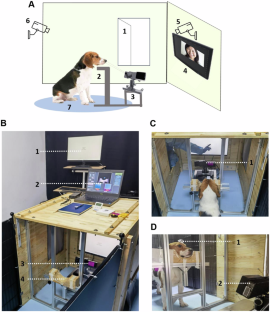
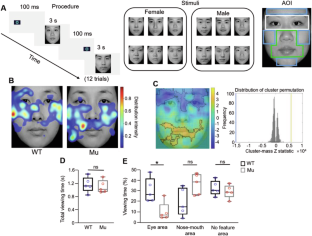



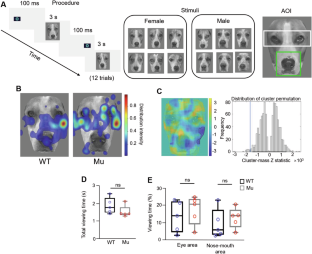



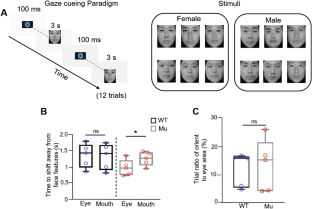



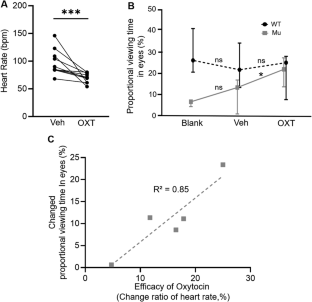



Data availability
The datasets generated and analyzed during the current study are available from the corresponding author upon request.
References
-
Association AP. Diagnostic and Statistical Manual of Mental Disorders. 5th edn. Washington, DC: American Psychiatric Publishing; 2013.
-
Adolphs R, Sears L, Piven J. Abnormal processing of social information from faces in autism. Autism. London: Routledge; 2013. p. 126–134.
-
Klin A, Jones W, Schultz R, Volkmar F, Cohen D. Visual fixation patterns during viewing of naturalistic social situations as predictors of social competence in individuals with autism. Arch Gen Psychiatry. 2002;59:809–16.
-
Emery NJ. The eyes have it: the neuroethology, function and evolution of social gaze. Neurosci Biobehav Rev. 2000;24:581–604.
-
Stuart N, Whitehouse A, Palermo R, Bothe E, Badcock N. Eye gaze in autism spectrum disorder: a review of neural evidence for the eye avoidance hypothesis. J Autism Dev Disord. 2023;53:1884–905.
-
Tanaka JW, Sung A. The “eye avoidance” hypothesis of autism face processing. J Autism Dev Disord. 2016;46:1538–52.
-
Chevallier C, Kohls G, Troiani V, Brodkin ES, Schultz RT. The social motivation theory of autism. Trends Cognit Sci. 2012;16:231–9.
-
Moriuchi JM, Klin A, Jones W. Mechanisms of diminished attention to eyes in autism. Am J Psychiatry. 2017;174:26–35.
-
Xu D, Zhi Y, Liu X, Guan L, Yu J, Zhang D, et al. WDR62-deficiency causes autism-like behaviors independent of microcephaly in mice. Neurosci Bull. 2023;39:1333–47.
-
Kaiser T, Zhou Y, Feng G. Animal models for neuropsychiatric disorders: prospects for circuit intervention. Curr Opin Neurobiol. 2017;45:59–65.
-
de la Torre-Ubieta L, Won H, Stein JL, Geschwind DH. Advancing the understanding of autism disease mechanisms through genetics. Nat Med. 2016;22:345–61.
-
Del Pino I, Rico B, Marín O. Neural circuit dysfunction in mouse models of neurodevelopmental disorders. Curr Opin Neurobiol. 2018;48:174–82.
-
Sato M, Nakai N, Fujima S, Choe KY, Takumi T. Social circuits and their dysfunction in autism spectrum disorder. Mol Psychiatry. 2023;28:3194–206.
-
Kelly E, Meng F, Fujita H, Morgado F, Kazemi Y, Rice LC, et al. Regulation of autism-relevant behaviors by cerebellar–prefrontal cortical circuits. Nat Neurosci. 2020;23:1102–10.
-
Jennings CG, Landman R, Zhou Y, Sharma J, Hyman J, Movshon JA, et al. Opportunities and challenges in modeling human brain disorders in transgenic primates. Nat Neurosci. 2016;19:1123–30.
-
Zhao H, Jiang YH, Zhang YQ. Modeling autism in non-human primates: Opportunities and challenges. Autism Res. 2018;11:686–94.
-
Persson ME, Sundman A-S, Halldén L-L, Trottier AJ, Jensen P. Sociality genes are associated with human-directed social behaviour in golden and Labrador retriever dogs. PeerJ. 2018;6:e5889.
-
Persson ME, Wright D, Roth LS, Batakis P, Jensen P. Genomic regions associated with interspecies communication in dogs contain genes related to human social disorders. Sci Rep. 2016;6:33439.
-
Topál J, Román V, Turcsán B. The dog (Canis familiaris) as a translational model of autism: It is high time we move from promise to reality. Wiley Interdiscip Reviews: Cognit Sci. 2019;10:e1495.
-
Galambos Á, Petró E, Nagy B, Turcsán B, Topál J. The effects of social and non-social distracting stimuli on dogs with different levels of social competence–Empirical evidence for a canine model of autism. Appl Anim Behav Sci. 2021;244:105451.
-
Somppi S, Törnqvist H, Hänninen L, Krause C, Vainio O. Dogs do look at images: eye tracking in canine cognition research. Anim Cogn. 2012;15:163–74.
-
Somppi S, Törnqvist H, Hänninen L, Krause CM, Vainio O. How dogs scan familiar and inverted faces: an eye movement study. Anim Cogn. 2014;17:793–803.
-
Virányi Z, Topál J, Gácsi M, Miklósi Á, Csányi V. Dogs respond appropriately to cues of humans’ attentional focus. Behavioural Process. 2004;66:161–72.
-
Gácsi M, Miklósi Á, Varga O, Topál J, Csányi V. Are readers of our face readers of our minds? Dogs (Canis familiaris) show situation-dependent recognition of human’s attention. Anim Cognition. 2004;7:144–53.
-
Hare B, Call J, Tomasello M. Communication of food location between human and dog (Canis familiaris). Evolution Commun. 1998;2:137–59.
-
Miklösi Á, Polgárdi R, Topál J, Csányi V. Use of experimenter-given cues in dogs. Anim Cognition. 1998;1:113–21.
-
Moessner R, Marshall CR, Sutcliffe JS, Skaug J, Pinto D, Vincent J, et al. Contribution of SHANK3 mutations to autism spectrum disorder. Am J Hum Genet. 2007;81:1289–97.
-
Boccuto L, Lauri M, Sarasua SM, Skinner CD, Buccella D, Dwivedi A, et al. Prevalence of SHANK3 variants in patients with different subtypes of autism spectrum disorders. Eur J Hum Genet. 2013;21:310–6.
-
Tian R, Li Y, Zhao H, Lyu W, Zhao J, Wang X et al. Modeling SHANK3-associated autism spectrum disorder in Beagle dogs via CRISPR/Cas9 gene editing. Mol Psychiatry. 2023;28:3739–3750.
-
Ren W, Huang K, Li Y, Yang Q, Wang L, Guo K et al. Altered pupil responses to social and non-social stimuli in Shank3 mutant dogs. Mol Psychiatry. 2023;28:3751–3759.
-
Téglás E, Gergely A, Kupán K, Miklósi Á, Topál J. Dogs’ gaze following is tuned to human communicative signals. Curr Biol. 2012;22:209–12.
-
Somppi S, Törnqvist H, Topál J, Koskela A, Hänninen L, Krause CM, et al. Nasal oxytocin treatment biases dogs’ visual attention and emotional response toward positive human facial expressions. Front Psychol. 2017;8:1854.
-
Kliemann D, Dziobek I, Hatri A, Steimke R, Heekeren HR. Atypical reflexive gaze patterns on emotional faces in autism spectrum disorders. J Neurosci. 2010;30:12281–7.
-
Le J, Kou J, Zhao W, Fu M, Zhang Y, Becker B, et al. Oxytocin facilitation of emotional empathy is associated with increased eye gaze toward the faces of individuals in emotional contexts. Front Neurosci. 2020;14:803.
-
Nagasawa M, Mitsui S, En S, Ohtani N, Ohta M, Sakuma Y, et al. Oxytocin-gaze positive loop and the coevolution of human-dog bonds. Science. 2015;348:333–6.
-
Nagasawa M, Ogawa M, Mogi K, Kikusui T. Intranasal oxytocin treatment increases eye-gaze behavior toward the owner in ancient Japanese dog breeds. Front Psychol. 2017;8:1624.
-
Yi L, Wang Q, Song C, Han ZR. Hypo‐or hyperarousal? The mechanisms underlying social information processing in autism. Child Dev Perspect. 2022;16:215–22.
-
Auyeung B, Lombardo MV, Heinrichs M, Chakrabarti B, Sule A, Deakin JB, et al. Oxytocin increases eye contact during a real-time, naturalistic social interaction in males with and without autism. Transl Psychiatry. 2015;5:e507–e507.
-
Gordon I, Vander Wyk BC, Bennett RH, Cordeaux C, Lucas MV, Eilbott JA, et al. Oxytocin enhances brain function in children with autism. Proc Natl Acad Sci. 2013;110:20953–8.
-
Karl S, Boch M, Virányi Z, Lamm C, Huber L. Training pet dogs for eye-tracking and awake fMRI. Behav Res Methods. 2020;52:838–56.
-
Gong X, Huang Y-X, Wang Y, Luo Y-J. Revision of the chinese facial affective picture system. Chin Ment Health J. 2011;25:40–46.
-
Wang Y, Luo Y-J. Standardization and assessment of college students’ facial expression of emotion. Chin J Clin Psychol. 2005;13:396–8.
-
Kis A, Kanizsár O, Gácsi M, Topál J. Intranasally administered oxytocin decreases heart rate and increases heart rate variability in dogs. J Veterinary Behavior: Clin Appl Res. 2014;9:e15.
-
Kovács K, Kis A, Kanizsár O, Hernádi A, Gácsi M, Topál J. The effect of oxytocin on biological motion perception in dogs (Canis familiaris). Anim Cognition. 2016;19:513–22.
-
Light KC, Grewen KM, Amico JA. More frequent partner hugs and higher oxytocin levels are linked to lower blood pressure and heart rate in premenopausal women. Biol Psychol. 2005;69:5–21.
-
Lawson EA, Marengi DA, DeSanti RL, Holmes TM, Schoenfeld DA, Tolley CJ. Oxytocin reduces caloric intake in men. Obesity. 2015;23:950–6.
-
Kemp AH, Quintana DS, Kuhnert R-L, Griffiths K, Hickie IB, Guastella AJ. Oxytocin increases heart rate variability in humans at rest: implications for social approach-related motivation and capacity for social engagement. PLoS One. 2012;7:e44014.
-
Schlegelmilch K, Wertz AE. Visual segmentation of complex naturalistic structures in an infant eye-tracking search task. PLoS One. 2022;17:e0266158.
-
Gharib A, Thompson BL. Analysis and novel methods for capture of normative eye-tracking data in 2.5-month old infants. PLoS One. 2022;17:e0278423.
-
Wang Q, Li X, Gong X, Yin T, Liu Q, Yi L et al. Autistic children’s visual sensitivity to face movement. Dev Psychopathol. 2023;36:1616–1625.
-
Maris E, Oostenveld R. Nonparametric statistical testing of EEG-and MEG-data. J Neurosci Methods. 2007;164:177–90.
-
Gutkowska J, Jankowski M, Mukaddam-Daher S, McCann S. Oxytocin is a cardiovascular hormone. Braz J Med Biol Res. 2000;33:625–33.
-
Cuve HC, Gao Y, Fuse A. Is it avoidance or hypoarousal? A systematic review of emotion recognition, eye-tracking, and psychophysiological studies in young adults with autism spectrum conditions. Res Autism Spectr Disord. 2018;55:1–13.
-
Kliemann D, Dziobek I, Hatri A, Baudewig J, Heekeren HR. The role of the amygdala in atypical gaze on emotional faces in autism spectrum disorders. J Neurosci. 2012;32:9469–76.
-
Mathersul D, McDonald S, Rushby JA. Autonomic arousal explains social cognitive abilities in high-functioning adults with autism spectrum disorder. Int J Psychophysiol. 2013;89:475–82.
-
Wang Q, Lu L, Zhang Q, Fang F, Zou X, Yi L. Eye avoidance in young children with autism spectrum disorder is modulated by emotional facial expressions. J Abnorm Psychol. 2018;127:722.
-
Dalton KM, Nacewicz BM, Johnstone T, Schaefer HS, Gernsbacher MA, Goldsmith HH, et al. Gaze fixation and the neural circuitry of face processing in autism. Nat Neurosci. 2005;8:519–26.
-
Siniscalchi M, d’Ingeo S, Minunno M, Quaranta A. Communication in dogs. Animals. 2018;8:131.
-
Horowitz A. Attention to attention in domestic dog (Canis familiaris) dyadic play. Anim Cogn. 2009;12:107–18.
-
van der Borg JA, Schilder MB, Vinke CM, de Vries H. Dominance in domestic dogs: a quantitative analysis of its behavioural measures. PLoS One. 2015;10:e0133978.
-
Correia-Caeiro C, Guo K, Mills D. Bodily emotional expressions are a primary source of information for dogs, but not for humans. Anim Cognition. 2021;24:267–79.
-
Wang G-D, Zhai W, Yang H-C, Fan R-X, Cao X, Zhong L, et al. The genomics of selection in dogs and the parallel evolution between dogs and humans. Nat Commun. 2013;4:1860.
-
Rossano F, Nitzschner M, Tomasello M. Domestic dogs and puppies can use human voice direction referentially. Proc R Soc B: Biol Sci. 2014;281:20133201.
-
Domes G, Heinrichs M, Michel A, Berger C, Herpertz SC. Oxytocin improves “mind-reading” in humans. Biol Psychiatry. 2007;61:731–3.
-
Menon R, Neumann ID. Detection, processing and reinforcement of social cues: regulation by the oxytocin system. Nat Rev Neurosci. 2023;24:761–77.
-
Le J, Zhang L, Zhao W, Zhu S, Lan C, Kou J, et al. Infrequent intranasal oxytocin followed by positive social interaction improves symptoms in autistic children: a pilot randomized clinical trial. Psychother Psychosom. 2022;91:335–47.
-
McEwen BS. Early life influences on life‐long patterns of behavior and health. Ment Retard Dev Disabil Res Rev. 2003;9:149–54.
-
Claessens SE, Daskalakis NP, van der Veen R, Oitzl MS, de Kloet ER, Champagne DL. Development of individual differences in stress responsiveness: an overview of factors mediating the outcome of early life experiences. Psychopharmacology (Berl). 2011;214:141–54.
Acknowledgements
This work was supported in part by by grants from the National Key Research and Development Program (2021ZD0203901 to Y.Q.Z.), the National Natural Science Foundation of China (32394030 to Y.Q.Z., 32200872 to Q.D.W., and 32271116 to L.Y.), Wuhan Municipal S&T Project (Grant No. 2024020702030125 to Y.Q.Z.), and the Canine Biobank, Chinese Academy of Sciences (KFJ-BRP-004 to Y.Q.Z.).
Author information
Authors and Affiliations
Contributions
LY and YQZ conceptualized the project, supervised data collection and analysis. YML, QDW and SQY designed and performed experiments. YML, QDW and LTK completed data collection and analysis. YML, QDW, LY, and YQZ wrote the manuscript, and KG, LY, and YQZ finalized the manuscript. YML and QDW contributed equally to this work as first contributing authors. LY and YQZ contributed equally to this work as supervisors.
Corresponding authors
Ethics declarations
Competing interests
The authors declare no competing interests.
Ethics approval and consent to participate
This study was conducted in full compliance with established guidelines for animal experimentation and received ethical approval from the Ethics Committee of the Institute of Genetics and Developmental Biology, Chinese Academy of Sciences (AP2022001).
Additional information
Publisher’s note Springer Nature remains neutral with regard to jurisdictional claims in published maps and institutional affiliations.
Supplementary information
41380_2025_2965_MOESM1_ESM.pdf
Supplementary figure 1 (Fig.S1), Supplementary figure 2 (Fig.S2), Supplementary table 1 (Table S1), Supplementary table 2 (Table S2)
Rights and permissions
Springer Nature or its licensor (e.g. a society or other partner) holds exclusive rights to this article under a publishing agreement with the author(s) or other rightsholder(s); author self-archiving of the accepted manuscript version of this article is solely governed by the terms of such publishing agreement and applicable law.
About this article
Cite this article
Li, Y., Wang, Q., Yuan, S. et al. Reduced attention to human eyes in autism-associated Shank3 mutant laboratory beagle dogs.
Mol Psychiatry (2025). https://doi.org/10.1038/s41380-025-02965-7
-
Received:
-
Revised:
-
Accepted:
-
Published:
-
DOI: https://doi.org/10.1038/s41380-025-02965-7
This post was originally published on this site be sure to check out more of their content.
